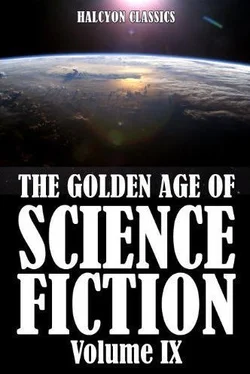“In the case of somewhat smaller rings we might perhaps see, here and there above the horizon, just the topmost peaks of some of the more lofty mountains.”
M’Allister was now struck with an idea, and exclaimed, “Professor, I notice that many of these great walled plains are very flat, and I should think they would make fine golf-links, for there would be plenty of room to send the ball flying!”
“Undoubtedly,” I answered, “you would have plenty of space for that; and I can tell you that you would be able to send the ball flying six times as far as you could on the earth with the same expenditure of force, because the moon’s gravitation is only one-sixth of that of the earth.”
“That would be grand,” said M’Allister. “I should like to have a few turns at golf on the moon.”
“Ah, but you would also have extra long tramps after your ball,” I told him, “so you would get plenty of exercise; but, for the reason already mentioned, you would be able to get over the ground six times as easily.”
“Well, Professor, I should not mind the distance in those circumstances,” he answered jauntily.
“Perhaps you like jumping exercise too,” I said. “Only fancy, M’Allister, if you wanted to jump across one of those narrower cracks! Why, if you could jump a distance of ten feet on the earth, you could jump sixty feet on the moon just as easily! Some of our athletes have jumped a length of twenty-six feet, so the same persons could with equal ease jump 156 feet on the moon! What do you think of that for a long jump?”
“Heh, Professor,” he replied, looking rather bewildered, “what a jump! Why, I should think the mon was never coming down again!”
“I say, though, M’Allister, after all I am inclined to think you would not find golf on the moon altogether a pleasant game,” said John.
“Why not, mon?” inquired M’Allister.
“Well,” answered John, “I was thinking that if you sent your ball flying into one of those cracks which are several miles deep you would find yourself eternally ‘bunkered,’ for no niblick ever made would get you out of that.”
M’Allister laughed so heartily at this idea of John’s that we both joined in his mirth; then I recommended him to wait until we reached Mars if he wished to enjoy a game of golf, for there he would be sure to find enormous stretches of level ground.
[Illustration: From a coloured drawing by M. Wicks Plate III
CHART OF THE MOON, SHOWING THE PRINCIPAL FORMATIONS SEEN ON ITS SURFACE
The dark areas are termed seas, though there is no water on the moon. The many small rings are ring-mountains and ring-plains. (The North Pole is at the top.)]
[Illustration: Plate IV
INDEX MAP TO CHART OF THE MOON
1. Bay of Rainbows
2. Plato
3. Sea of Cold
4. Alps Mountains
5. Great Alpine Valley
6. Cassini
7. Autolycus
8. Aristillus
9. Archimedes
10. Timocharis
11. Lambert
12. Euler
13. Sea of Showers
14. Aristarchus
15. Herodotus
16. Ocean of Storms
17. Copernicus
18. Apennine Mountains
19. Sea of Serenity
20. Haemus Mountains
21. Sea of Conflicts
22. Proclus
23. Sea of Tranquillity
24. Sea of Fertility
25. Hevel
26. Kepler
27. Grimaldi
28. Flamsteed
29. Bonpland
30. Gassendi
31. Sea of Vapours
32. Hipparchus
33. Albategnius
34. Ptolemæus
35. Alphonsus
36. Arzachel
37. Theophilus
38. Cyrillus
39. Catherina
40. Sea of Nectar
41. Langrenus
42. Vendelinus
43. Petavius
44. Schickard
45. Wargentin
46. Tycho
47. Maurolycus
48. Clavius
49. Newton
50. Straight Wall
51. Sea of Moisture
52. Sea of Clouds]
Proceeding on our tour of inspection, we crossed the Ocean of Storms to a point near the central part of the lunar surface, and I showed them the fine walled plain called Ptolemæus. This is 115 miles in diameter, and contains an area as large as the combined areas of Yorkshire, Lancashire, and Westmorland, its highest peak being 9000 feet in altitude. It forms the most northerly of a line of walled plains, the most southerly being Arzachel, which is sixty-six miles in diameter, and has a very depressed floor; while one peak on the walls rises to a height of 13,000 feet.
Passing farther west, we next examined another splendid group of three ring-mountains, arranged in a line running nearly north and south, viz. Theophilus, Cyrillus, and Catherina. The first is the most northerly, and is about sixty-four miles in diameter, with several very high peaks—one rising as much as 18,000 feet, and two on the opposite side being 16,000 and 14,000 feet high respectively. Even the central mountain is very large in area, and 6000 feet high. “That,” I remarked to M’Allister, “is nearly half as high again as Ben Nevis, the highest mountain in Scotland, which is, after all, only 4400 feet high.”
“Ben Nevis, Professor, is 4406 feet high!” corrected M’Allister.
“That’s right, M’Allister,” said John, clapping him on the back, “stick up for bonnie Scotland, and don’t let her be robbed of that six feet of mountain!”
Proceeding, I then said that Cyrillus, the middle ring, was, as they could see, very irregular in shape; and the walls were in some parts very much broken and damaged.
Catherina is the largest of the three, being over seventy miles in diameter, and its highest peak is 16,500 feet in altitude.
I should have liked to have shown them the splendid double-walled plain called Petavius, which has a convex floor some 800 feet higher in the centre than at the edges. We were, however, too late both for that and Langrenus, another fine formation on the same meridian, for the sun had set upon them and they were in darkness, so it was no use going any farther in that direction.
We now directed our course over the Sea of Clouds till we arrived at what is known as the “Straight Wall.”
“M’Allister,” I said, “that ought to interest you, for there is a somewhat similar formation in Scotland. You see this is an escarpment, or cliff, over sixty miles long, and varying from about 600 feet to 900 feet in height.
“This cliff is one of the best known examples on the moon of what in geology is termed a ‘fault,’ indicating either that one part of the general surface has been greatly elevated, or that the adjoining part has been depressed. We have many examples of such ‘faults’ on the earth—for instance, one runs a long way across Scotland, from Stonehaven round to Helensburgh, between the Highlands and the Lowlands, and is about 120 miles in length. That is about twice the length of the Straight Wall; so you see that Scotland can beat the moon in that respect!”
This brought M’Allister up to the scratch. “Scotland,” he exclaimed excitedly, “can hold her own in most things! Why, mon, the empire is indebted to her for the finest statesmen, the cleverest lawyers, the best engineers and scientists, and, allow me to say, the bravest soldiers in the whole world! Scotsmen go everywhere, and can do anything!”
“Oh yes, M’Allister,” said John, with a laugh, “and a Scotsman has got to the moon! but, please, do not forget that two Englishmen planned the trip, and devised the means of accomplishing the journey!”
M’Allister smiled a rather wintry smile, and then subsided. John was a bit too smart for him that time.
Passing on, we inspected the large cleft running parallel to the Straight Wall, and the small mountain close by named after Birt, the well-known selenographer. We then crossed the Sea of Clouds again, and had a long look at the great system of straight clefts near Campanus and Hippalus, together with the fine walled plain Gassendi, the floor of which is at some parts 2000 feet above the lunar surface. I had often studied this through the telescope, as it is a most interesting formation.
Читать дальше












